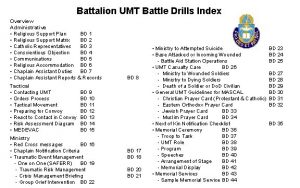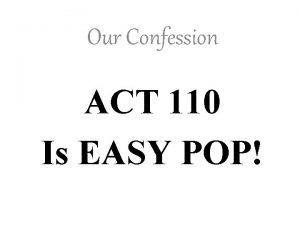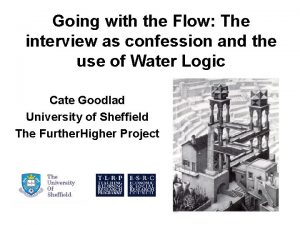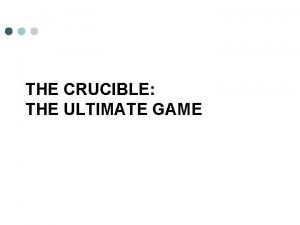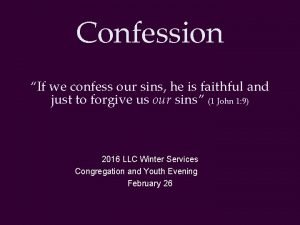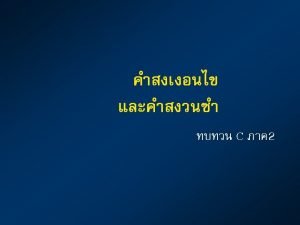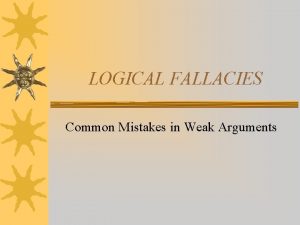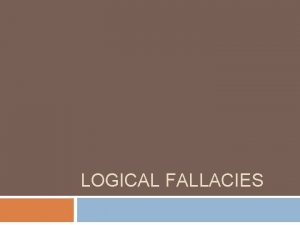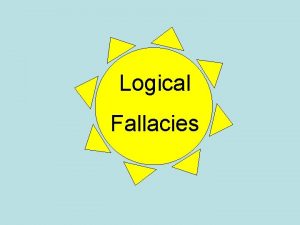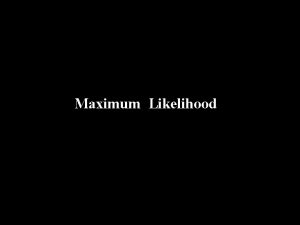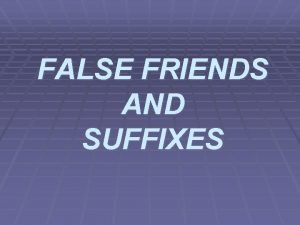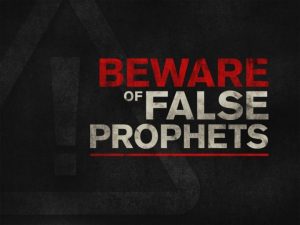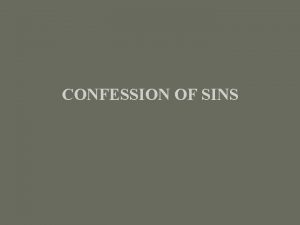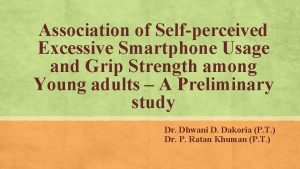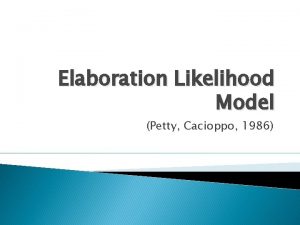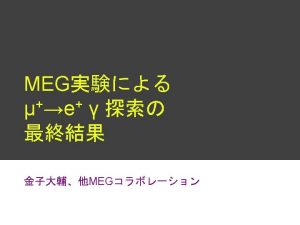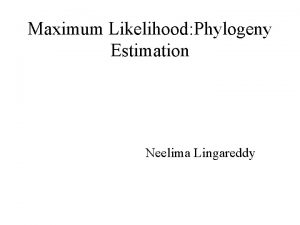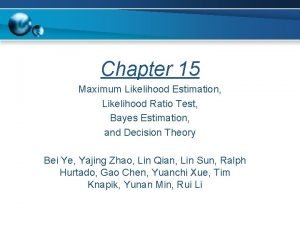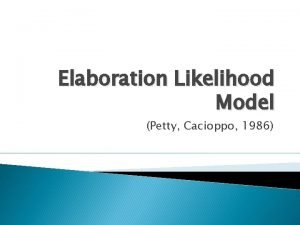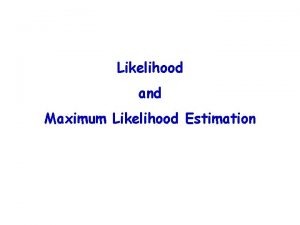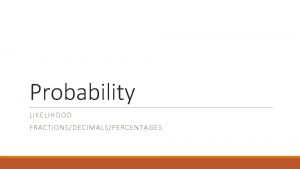SELFPERCEIVED LIKELIHOOD OF FALSE CONFESSION A COMPARISON OF
















- Slides: 16

SELF-PERCEIVED LIKELIHOOD OF FALSE CONFESSION: A COMPARISON OF JUVENILE AND ADULT OFFENDERS Emily Haney-Caron, M. S. , Elizabeth Gale-Bentz, B. A. , Sharon Kelley, J. D. , Ph. D. , Leah Brogan, M. S. , & Naomi Goldstein, Ph. D. 2015 American Psychology-Law Society Conference

The Problem of False Confession 16% of DNA exonorees falsely confessed to crime (Garrett, 2008) q Police investigators estimate 5% of innocent suspects falsely confess during interrogation (Kassin et al. , 2007) q Confessions increase likelihood of conviction (Kassin & Wrightsman, 1980) q

Belief in evidence indicating guilt Belief leniency will result Mental Illness Risk Factors for False Confession Intellectual disability Young age Suggestive interviewin g techniques

Correlates of False Confession Among Juveniles Poor Miranda comprehensi on Use of police or parental pressure Suggestibilit y Immature decisionmaking abilities Young age Impulsiven ess Low IQ Desire to comply with authority Failure to consider long-term consequen ces

Methods: Participants Juveniles Adults � Pre- and post-adjudication � Post-sentencing adults in adolescents at sites in PA & Philadelphia Prison System MA � 39 men, 53 women � 125 boys, 43 girls � Ages 21 - to 65 -years-old � Ages 12 - to 19 -years-old (M = 36. 23; SD = 9. 80) (M = 15 -91; SD = 1. 69)African American Caucasian Hispanic Asian American Other, including bi-racial

Methods: Procedures Consent or assent obtained q Tests administered individually at juvenile justice or correctional facilities q q Private, quiet rooms q Testing sessions conducted by trained research assistants

Methods: Measures P-CHIP Vignette: � Crime: Man reported someone stole his watch and kicked him � Police think a 14 -year-old boy named Joe Stole the watch, and Kicked the man � 26 interrogation situations Directive Non-Directive Suppose Joe did not do either of these two crimes: He did not steal the watch or kick the man. Right now, will he say he did it anyway? Definitely Probably A little Probably Definitely no 0 no no yes yes 5

Methods: Measures Comprehension of Miranda Rights – II Recognition – II (CMR-R(CMR-II) Miranda Rights Comprehension Instruments (MRCI) Comprehension of Miranda Vocabulary – II (CMV-II) Function of Rights in Interrogation (FRI)

Methods: Measures q Gudjonsson Suggestibility Scale-2 q Demographics questionnaire

Hypotheses Self-reported false-confession likelihood: � Juveniles > Adults Highest for 12 -14 year olds Mediation: Suggestibility False Confession Score Age Miranda Comprehension

Results: Self-reported likelihood of false confession by age Leaning towards Definitely would χ2 (3, N = 260) = 16. 10, p < 0. 01 χ2 (3, N = 260) = 27. 12, p < 0. 01 70% 63% 45% 42% 29% 30% 23% 18% 12 -14 15 -16 17 -19 Adult

Results: Average P-CHIP item score for each category of interrogation tactic by age *p <. 01 t (130) = 2. 86, p =. 01 3 2. 5 2 12 -14 15 -16 1. 5 17 -19 1 Adult 0. 5 0 Directive F (3, 256) = 6. 33, p < . 01 Non-directive F (3, 256) = 3. 93, p =. 01

Results: Mediation Suggestibility False Confession Score Age Miranda Comprehension Proposed Mediator Whole Model 95% CI CMR-II [-0. 49, 0. 02] [-0. 11, 0. 32] CMR-R [-0. 27, 0. 02] FRI [-0. 17, 0. 14]

Implications Greater protections for youth under 15 years of age, such as: (e. g. , Birckhead, 2008; Feld, 2006) �Videotaping of all interrogations �Discourage police from using certain tactics with young juveniles (Feld, 2006) Certain types of directive techniques Implying leniency Using false evidence

Limitations and Future Directions LIMITATIONS Self-report instrument Ecological Validity � Stress & suggestibility FUTURE DIRECTIONS Further assess validity of the P-CHIP (e. g. , Gudjonsson & Singh, 1984; Richardson et al. , 1995) Underestimation of false confession likelihood? Examine other mediators of age and false confession Evaluate impact of suggested protections on false confession behavior

Thank you! ehh 29@drexel. edu
 Umt confession
Umt confession Prayer before confession
Prayer before confession Confession
Confession Philadelphia confession of faith
Philadelphia confession of faith General confession ame church
General confession ame church Bgu confession
Bgu confession Confession
Confession Flowscape alternative
Flowscape alternative What does elizabeth do when called upon to testify? *
What does elizabeth do when called upon to testify? * Congregational confession this is my bible
Congregational confession this is my bible Confession coptic orthodox
Confession coptic orthodox Confession types
Confession types If ? true : false
If ? true : false Amer rasheed
Amer rasheed Post hoc ergo propter hoc fallacy
Post hoc ergo propter hoc fallacy False equivalence
False equivalence Red herring fallacy
Red herring fallacy
